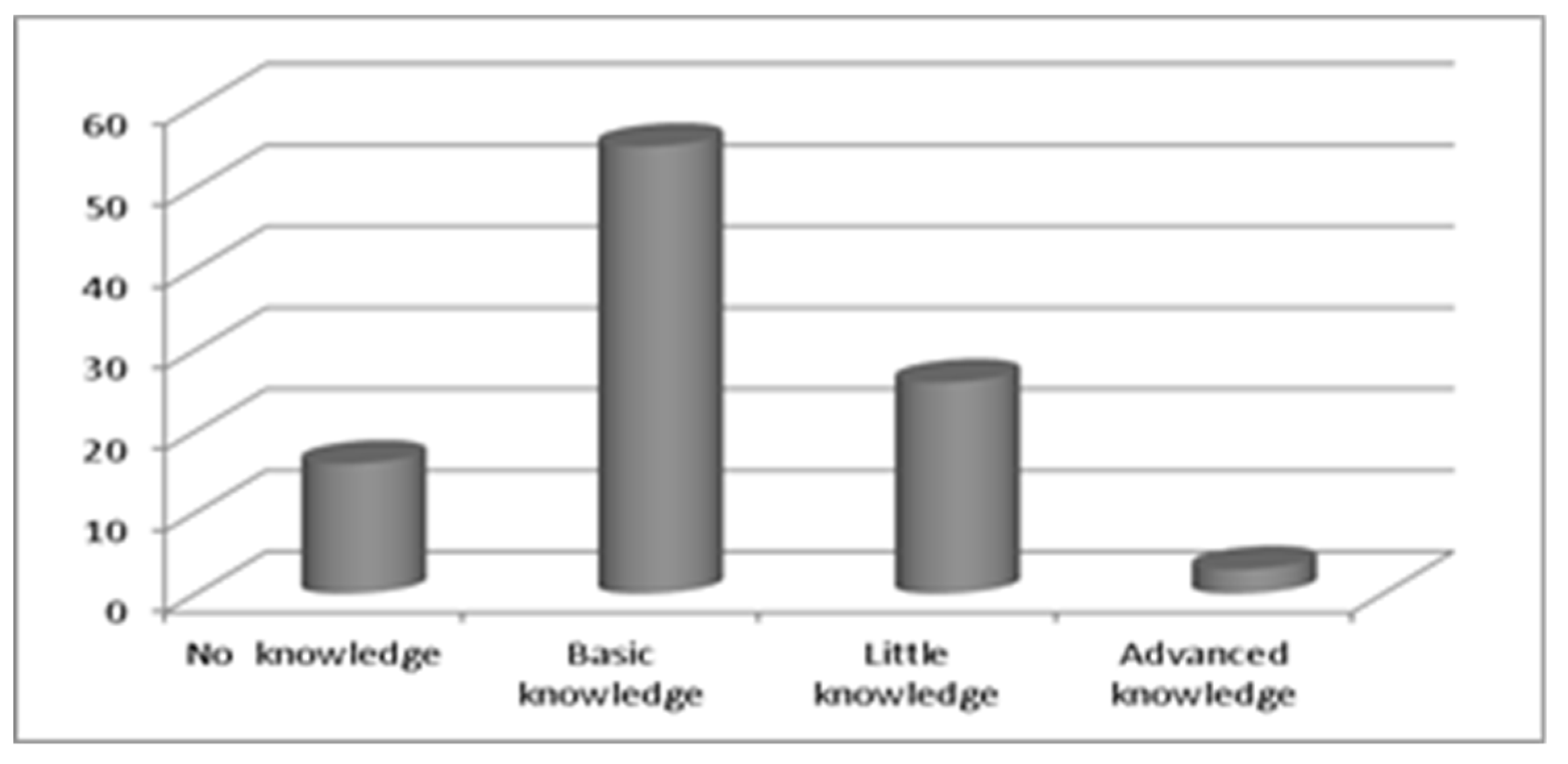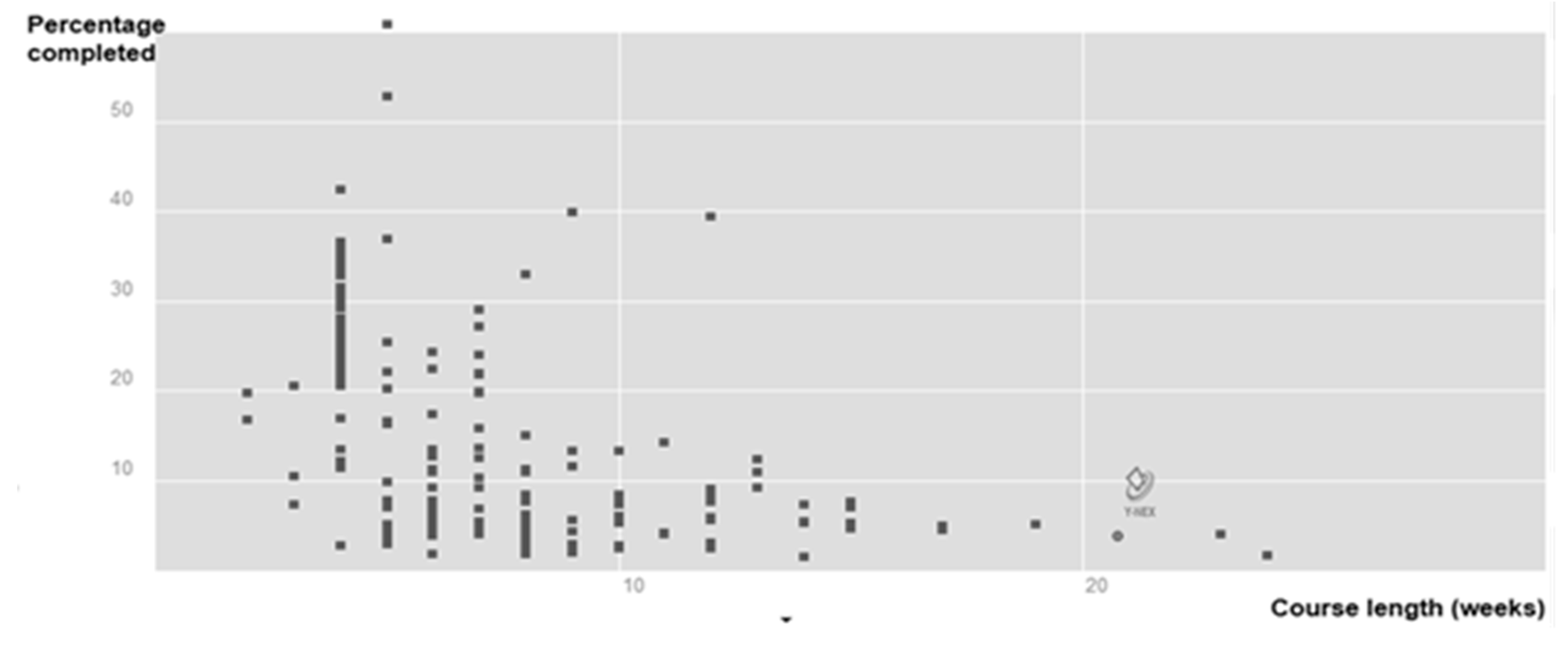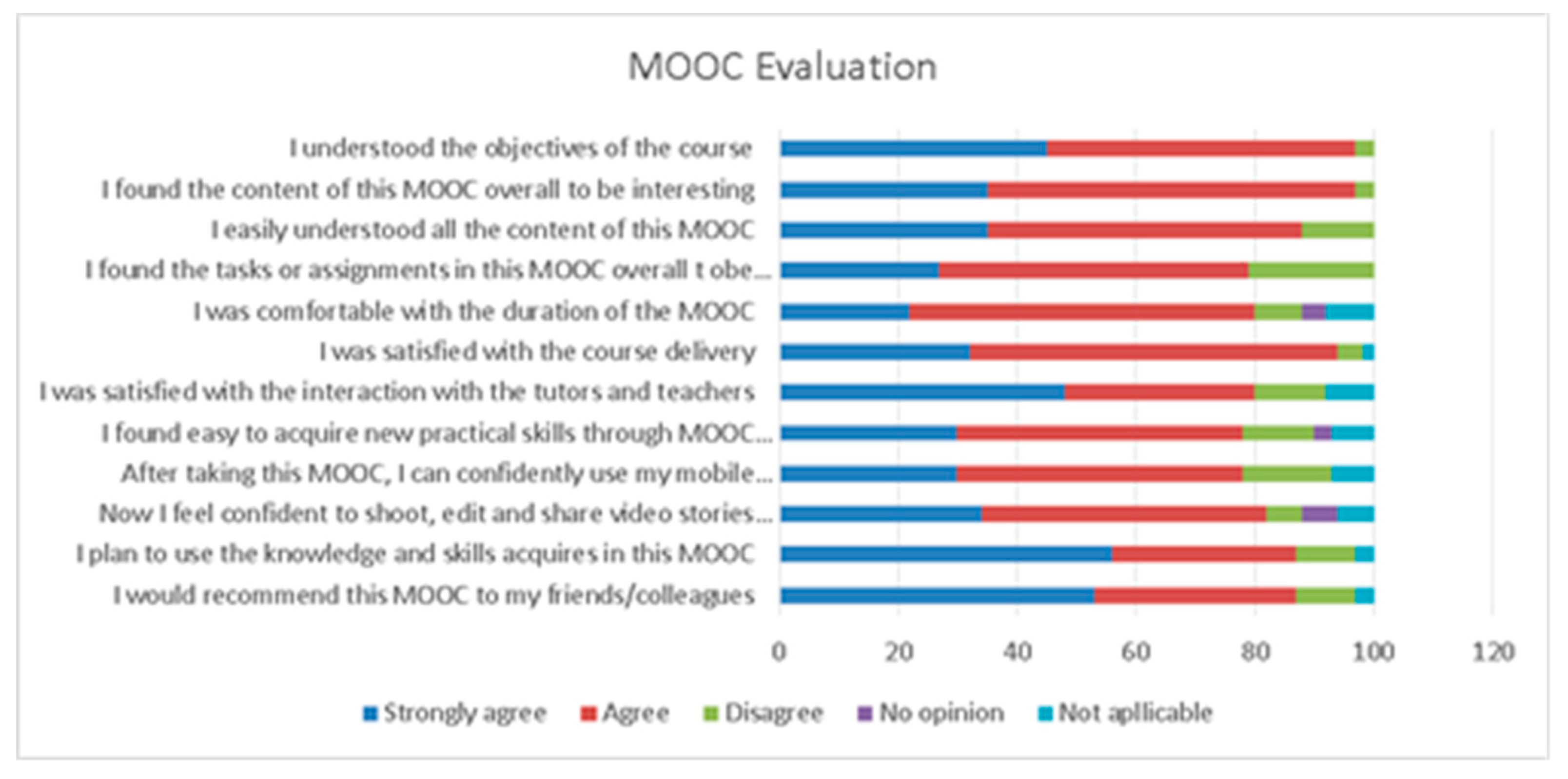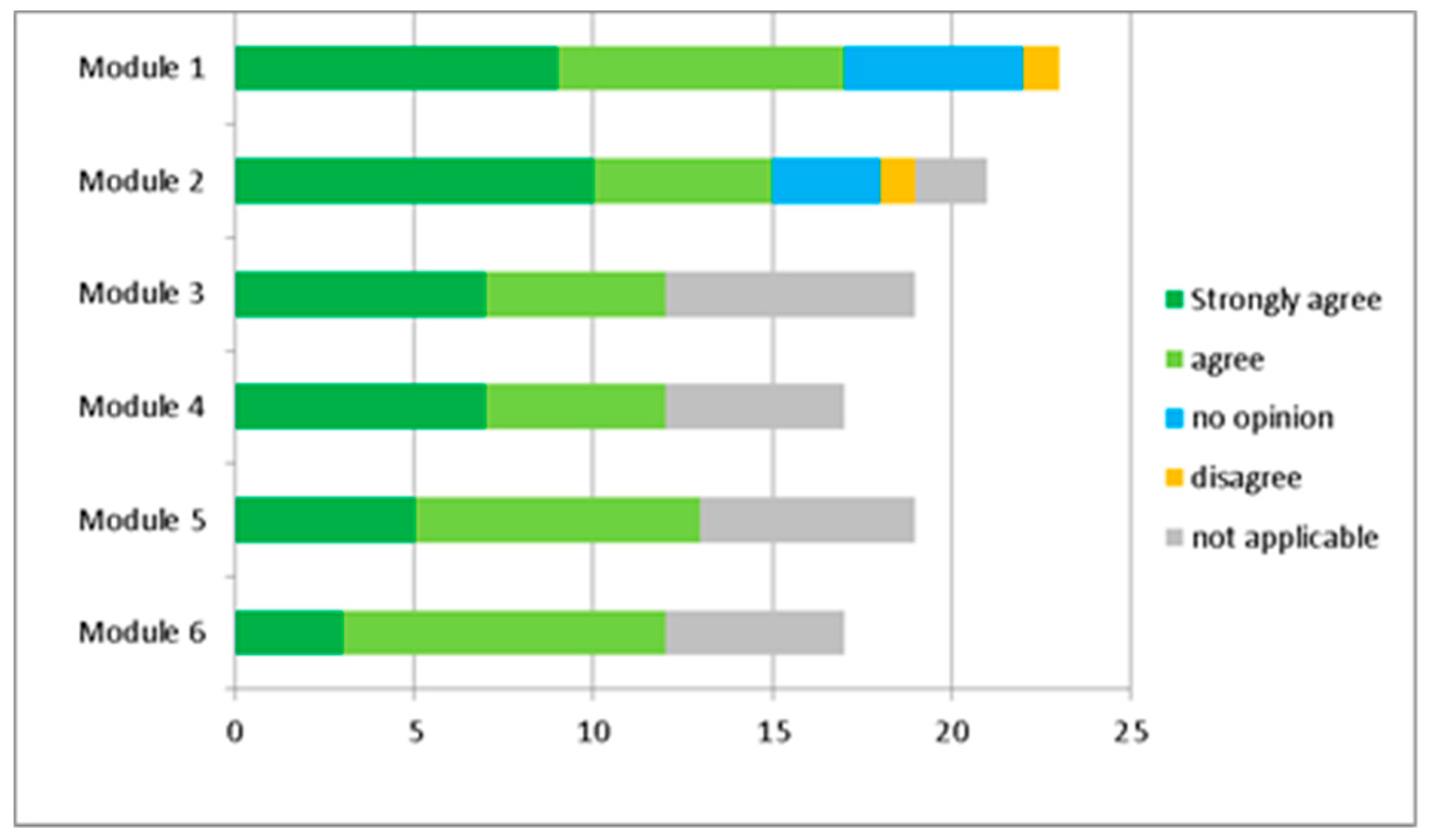The Challenge of Teaching Mobile Journalism through MOOCs: A Case Study
Abstract
1. Introduction
2. Theoretical Background
2.1. Defining Mobile Journalism
2.2. Mobile Journalism Education and Training
Overview of Existing Experiences
3. Y-NEX MOOC
4. Materials and Methods
5. Results
5.1. Numbers and Participants Profile
5.2. Enrollment, Course Completion and Participation
5.3. Participant Evaluation
5.4. Results Per Module
5.5. Qualitative Assessment
“Good content, delivery and interactions of all teachers throughout the period of training.
I liked the “immersiveness” in the tasks which needed to be completed.
Interesting examples from journalists’ everyday life, really detailed feedback for some tasks, flexible deadlines
Real life situation.
It taught me about this new perspective of pursuing people and their story from mobile point of view. Now I can easily distinguish relevant from less important and I know how to present information to the public the right way that is objective as much as possible, informative, balanced and truthful.
As far as I noticed, it was really professional. I liked the forums and conversations between participants and mentors.
The tasks were interesting.
The practical assignments were more than useful. They were very educational.
I’d say discussions we had through forum really helped me to see bigger picture of mobile journalism as well as of professional ethics, so I think those forums were useful. Also, I liked all of practical tasks and I wished there was more of them because they push you to go outside, to talk to variety of people and ask them about their story, and that’s really important to know as journalist. I think using videos as the main platform to educate is genius because through interactive maps and video element, it made the course more interesting and fun.”
“I wish there was more practical tasks because I really enjoyed them.
It took some time for tutors to grade the tasks.
My lack of time.
Not enough time.
I’m really sorry I couldn’t follow the course because of my professional obligations.
Some of the documentation was too obvious, but certainly I understand that the purpose was to reach all audiences.
Sometimes the feedback on the assignments was late, but I also appreciate the big number of participants’ assignments that needed to be corrected.
The duration of MOOC, I feel like it could’ve been done in a shorter amount of time.
Unfortunately, I didn’t have enough time to follow it due to my professional career.”
“Maybe something about getting the participants to cooperate on some tasks or something like that, and the instructors were great, I actually regret that I can’t listen to some of them lecture.
Maybe less texts on videos and talking slow and clear English. Just a suggestion!
Maybe provide more insight in how you grade assignments.
More examples to catch their interest and show them the benefits of MOOC.
The only suggestion I can give is to work on the combination of all course content into one PDF format for accessibility and convergence.
Using Slido or similar site or make a Facebook group.
More videoconferences, maybe.
You can maybe organize webinars or live chats or something like this. It should encourage participants to discuss more topics and ask questions.
Maybe FaceTime communicating possibility.
A web conference?”
6. Discussion and Conclusions
Author Contributions
Funding
Acknowledgments
Conflicts of Interest
Appendix A
Appendix A1. SURVEY POPULATION
- Country of origin
- Education level
- Occupation
- How did you hear about this MOOC?
- Prior knowledge
- Motivation
- Number of modules completed
- Reasons to stop MOOC participation
Appendix A2. PARTICIPANT OPINION
- I understood the objectives of the course.
- I find the content of this MOOC overall to be interesting.
- I easily understood all the content of this MOOC.
- I find the tasks or assignments in this MOOC overall to be interesting and stimulating.
- I was comfortable with the duration of the MOOC.
- I was satisfied with the course delivery.
- I felt free to ask questions throughout this course.
- I was satisfied with the interaction with the tutors and teachers.
- I find it easy to acquire new practical skills through MOOC learning.
- After taking this MOOC, I can confidently use my mobile journalism knowledge and skills.
- Now I feel confident to shoot, edit and share video stories using only my smartphone.
- I plan to use the knowledge and skills acquired in this MOOC.
- I would recommend this MOOC to my friends/colleagues.
- Strongly agree
- Agree
- No opinion
- Disagree
- Strongly disagree
- Not applicable
- (a)
- Effort required
- Too little
- Just right
- Too much
- (b)
- Time range
- Too little
- Just right
- Too much
- (c)
- How much time did you spend to complete the activities?
| N | 31 |
| Average | 158 min |
| Standard deviation | 104 |
| Median | 150 min |
| Mode | 60 min |
Appendix A3. RESULTS PER MODULE (for each Module)
| 1.The respondents were asked to rate their general feelings and impressions about each module. |
- The trainers of this module were responsive.
- I found the assignments useful and engaging.
- I found the multimedia materials useful for the course content.
- I learnt a lot in this module.
- I found this module easy to understand.
- Strongly Agree
- Agree
- No opinion
- Disagree
- Strongly Disagree
- Not applicable
- (a)
- Effort required
- Too little
- Just right
- Too much
- (b)
- Time range
- Too little
- Just right
- Too much
- (c)
- How much time did you spend to complete the activities?
| N | 31 |
| Average | 158 min |
| Standard deviation | 104 |
| Median | 150 min |
| Mode | 60 min |
References
- Cervi, L. Citizen Journalism And User Generated Content In Mainstream Media. New Dialogic Form Of Communication, User-Engagement Technique Or Free Labor Exploitation? Revista de Comunicaçao Dialogica 2017, 1, 120–141. [Google Scholar] [CrossRef]
- Westlund, O. Mobile News: A review and model of journalism in an age of mobile media. Digit. Journal. 2013, 1, 6–26. [Google Scholar] [CrossRef]
- Canavilhas, J. Modelos informativos para aparatos móviles: Información hipermultimediática y personalizada. In Congreso Latina de Comunicación Social; Universidad de la Laguna: Tenerife, Spain, 2012. [Google Scholar]
- Briggs, M. Journalism Next; Sage: Los Angeles, CA, USA, 2016. [Google Scholar]
- Robinson, S.; DeShano, C. ‘Anyone can know’: Citizen journalism and the interpretive community of the mainstream press. Journalism 2011, 12, 963–982. [Google Scholar] [CrossRef]
- Kovach, B.; Rosenstiel, T. The Elements of Journalism: What Newspeople Should Know and the Public Should Expect; Three Rivers Press: New York, NY, USA, 2007. [Google Scholar]
- Larrea Maccise, D.; Marai, M. (Eds.) Mobile Journalism; Al Jazeera Media Institute: Doha, Qatar, 2012; Available online: https://bit.ly/2zFn9AJ (accessed on 2 March 2020).
- Lewis, S.C.; Westlund, O. Mapping the Human-Machine Divide in Journalism. In The Sage Handbook of Digital Journalism; Witschge, T., Anderson, C.W., Domingo, A., Eds.; Sage: London, UK, 2016; pp. 341–353. [Google Scholar]
- Hermida, A. #Journalism: Reconfiguring journalism research about Twitter, one tweet at a time. Digit. Journal. 2013, 1, 295–313. [Google Scholar] [CrossRef]
- Reich, J. The Impact of Technology on News Reporting: A Longitudinal Perspective. Journal. Mass Commun. Q. 2013, 90, 417–434. [Google Scholar] [CrossRef]
- Quinn, S. MoJo—Mobile journalism in the Asian Region; Konrad-Adenauer-Stiftung: Singapore, 2009. [Google Scholar]
- Aguaded, J.I.; Cabero, J. Avances y retos en la promoción de la innovación didáctica con las tecnologías emergentes e interactivas. Educar 2014, 50, 67–83. [Google Scholar] [CrossRef]
- Romero-Rodríguez, L.M.; Ramírez-Montoya, M.S.; Valenzuela-González, J.R. Incidence of Digital Competences in The Completion Rates of Moocs: Case Study On Energy Sustainability Courses. IEEE Trans. Educ. 2020. [Google Scholar] [CrossRef]
- Pavlik, J. New Media and News: Implications for the Future of Journalism. New Media Soc. 1999, 1, 59–66. [Google Scholar] [CrossRef]
- Pavlik, J. The Impact of Technology on Journalism. Journal. Stud. 2010, 1, 229–237. [Google Scholar] [CrossRef]
- Boczkowski, P.J. The processes of adopting multimedia and interactivity in three online newsrooms. J. Commun. 2004, 54, 197–213. [Google Scholar] [CrossRef]
- Tejedor Calvo, S.; Cervi, L. Análisis de los estudios de Periodismo y Comunicación en las principales universidades del mundo. Competencias, objetivos y asignaturas. Revista Latina de Comunicación Soc. 2017, 72, 1626–1647. [Google Scholar] [CrossRef]
- Cervi, L.; Simelio, N.; Tejedor Calvo, S. Analysis of Journalism and Communication Studies in Europe’s Top Ranked Universities: Competencies, Aims and Courses. Journal. Pract. 2020. [Google Scholar] [CrossRef]
- Rodgers, S. Foreign Objects? Web Content Management Systems, Journalistic Cultures and the Ontology of Software. Journalism 2015, 1, 16–26. [Google Scholar] [CrossRef]
- Quinn, S. Knowledge Management in the Digital Newsroom; Focal Press: Oxford, UK, 2013. [Google Scholar]
- Slivka, J. The Things We Carry and Don’t. Judd Slivka. 2017. Available online: http://www.juddslivka.com/philosophy-and-gear-packs-2017Author (accessed on 1 May 2019).
- Burum, I.; Quinn, S. The Mobile Journalism Handbook; Focal Press: London, UK, 2016. [Google Scholar]
- López-García, X.; Rodríguez-Vázquez, A.; Pereira-Fariña, X. Technological Skills and New Professional Profiles: Present Challenges for Journalism. Comunicar 2017, 53, 81–90. [Google Scholar] [CrossRef]
- Wenger, D.; Owens, L.; Thompson, P. Help Wanted: Mobile journalism Skills Required b Top U.S. News Companies. Electron. News 2014, 8, 138–149. [Google Scholar] [CrossRef]
- Palomo, B. El periodista on-line: De la revolución a la evolución; Comunicación Social: Seville, Spain, 2004. [Google Scholar]
- Kovačević, P.; Perišin, T. Mobile Journalism Training: Best practices for good story telling. Digitalne Medijske Tehnologije 2016, 1, 179–191. [Google Scholar]
- Becker, L.B.; Vlad, T.; Desnoes, P. Enrollments decline slightly and the student body becomes more diverse. Journal. Mass Commun. Educ. 2010, 65, 224–249. [Google Scholar] [CrossRef]
- Wardle, C.S.; Dubberley, S.; Brown, P.D. Amateur Footage: A Global Study of User-Generated Content; Tow Center for Digital Journalism, Columbia University: New York, NY, USA, 2014. [Google Scholar]
- Chaturvedi, R.; Mehrotra, S. Mobile News Gathering: Media Enterpreneurship and Participation of Marginalized Communities in News Gathering Structure. Int. J. Appl. Res. Stud. 2013, 2, 1–17. [Google Scholar]
- Rutigliano, L.W. Covering the Unknown City: Citizen Journalism and Marginalized Communities. Ph.D. Thesis, The University of Texas at Austin, Austin, TX, USA, 2008. Available online: https://bit.ly/2R5Fy0x (accessed on 25 March 2019).
- Baer, L.; Campbell, J.P. From metrics to analytics, reporting to action: Analytics’ role in changing the learning environment. In Game Changers. Education and Information Technologies; Oblinger, D., Ed.; Educause: Washington, DC, USA, 2012; pp. 53–67. [Google Scholar]
- Reich, J. Rebooting MOOC research. Science 2015, 347, 30–31. [Google Scholar] [CrossRef]
- Maartje, A.; Henderikx, K.; Kalz, M. Refining success and dropout in massive open online courses based on the intention–behaviour gap. Distance Educ. 2017, 38, 353–368. [Google Scholar] [CrossRef]
- Koller, D.; Chuong, D.A.; Zhenghao, C. Intention and Retention in Massive Open Online Courses. Educ. Rev. 2013, 48, 62–63. [Google Scholar]
- Romero-Rodríguez, L.M.; Ramírez-Montoya, M.S.; Aguaded, I. Determining Factors in Moocs Completion Rates: Application Test in Energy Sustainability Courses. Sustainability 2020, 12, 2893. [Google Scholar] [CrossRef]
- Ho, A.; Chuang, I.; Reich, J.; Coleman, C.; Whitehill, J.; Northcutt, C.; Williams, J.; Hansen, J.; Lopez, G.; Petersen, R. HarvardX and MITx: Two Years of Open Online Courses Fall 2012-Summer 2014. SSRN Electron. J. 2015. [Google Scholar] [CrossRef]
- Hayes, S. MOOCs and Quality: A Review of the Recent Literature; Quality Assurance Agency for Higher Education: Gloucester, UK, 2015; p. 1288. Available online: https://bit.ly/2OU9Cuh (accessed on 26 March 2019).
- Cross, S. Evaluation of the OLDS MOOC Curriculum Design Course: Participant Perspectives, Expectations and Experiences; OLDS MOOC Project; OLDS MOOC: Milton Keynes, UK, 2013; Available online: http://oro.open.ac.uk/37836/ (accessed on 12 April 2019).
- Yousef, A.; Chatti, M.; Wosnitza, M.; Schroeder, U. A Cluster Analysis of MOOC Stakeholder Perspectives. RUSC. Univ. Knowl. Soc. J. 2015, 12, 74–90. [Google Scholar] [CrossRef]
- Christensen, G.; Steinmetz, A.; Emanuel, E. The MOOC Phenomenon: Who Takes Massive Open Online Courses and Why? University of Pennsylvania: Philadelphia, PA, USA, 2013. [Google Scholar]
- Hansen, E. The positive freedom of the public sphere. Journal. Stud. 2015, 16, 767–781. [Google Scholar] [CrossRef]
- Jordan, K. Massive open online course completion rates revisited: Assessment, length and attrition. Int. Rev. Res. Open Distrib. Learn. 2015, 16, 341–358. [Google Scholar] [CrossRef]
- Hadi, S.M.; Gagen, P. New Model for Measuring MOOCs Completion Rates. European MOOCs Stakeholder Summit. 2016. Available online: https://www.researchgate.net/publication/296705001_New_model_for_measuring_MOOCs_completion_rates (accessed on 17 April 2019).
- Young, J.R. Are Courses Outdated? MIT Considers Offering ‘Modules’ Instead; The Chronicle of Higher Education Inc.: Washington DC, USA, 2014. [Google Scholar]
- Romero-Rodríguez, L.M.; Ramírez-Montoya, M.S.; Valenzuela González, J.R. Gamification in Moocs: Engagement Application Test In Energy Sustainability Courses. IEEE Access 2019, 7, 32093–32101. [Google Scholar] [CrossRef]
- Jordan, K. Initial Trends in Enrolment and Completion of Massive Open Online Courses. Int. Rev. Res. Open Distance Learn. 2014, 15, 133–160. [Google Scholar] [CrossRef]






| Y-NEX | edX (Average) | Coursera (Average) | Various (Average) | |
|---|---|---|---|---|
| Completion rate (Enrolled) | 3% | 5% | 3% | 6.5% |
| Completion rate (Active) | 10% | 8% | 5% | 10% |
© 2020 by the authors. Licensee MDPI, Basel, Switzerland. This article is an open access article distributed under the terms and conditions of the Creative Commons Attribution (CC BY) license (http://creativecommons.org/licenses/by/4.0/).
Share and Cite
Cervi, L.; Pérez Tornero, J.M.; Tejedor, S. The Challenge of Teaching Mobile Journalism through MOOCs: A Case Study. Sustainability 2020, 12, 5307. https://doi.org/10.3390/su12135307
Cervi L, Pérez Tornero JM, Tejedor S. The Challenge of Teaching Mobile Journalism through MOOCs: A Case Study. Sustainability. 2020; 12(13):5307. https://doi.org/10.3390/su12135307
Chicago/Turabian StyleCervi, Laura, José Manuel Pérez Tornero, and Santiago Tejedor. 2020. "The Challenge of Teaching Mobile Journalism through MOOCs: A Case Study" Sustainability 12, no. 13: 5307. https://doi.org/10.3390/su12135307
APA StyleCervi, L., Pérez Tornero, J. M., & Tejedor, S. (2020). The Challenge of Teaching Mobile Journalism through MOOCs: A Case Study. Sustainability, 12(13), 5307. https://doi.org/10.3390/su12135307






